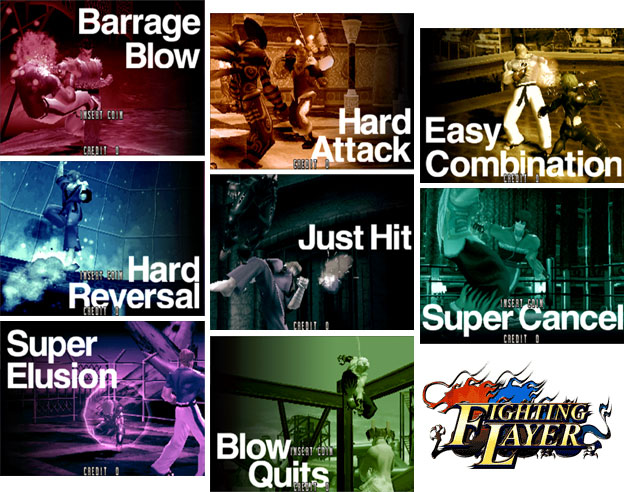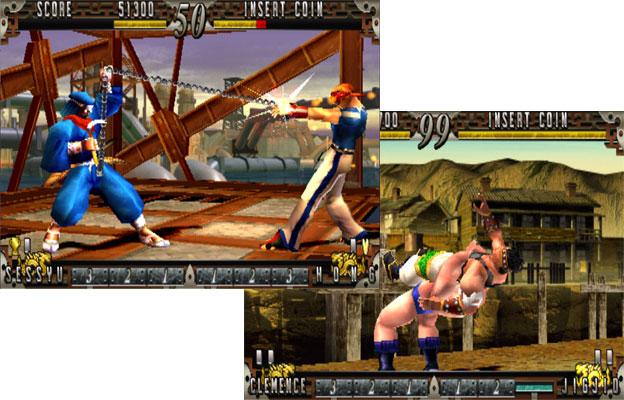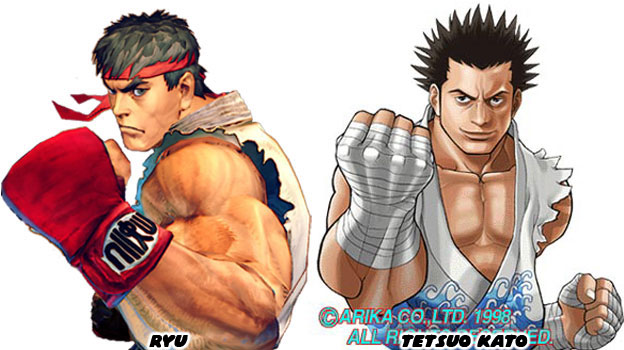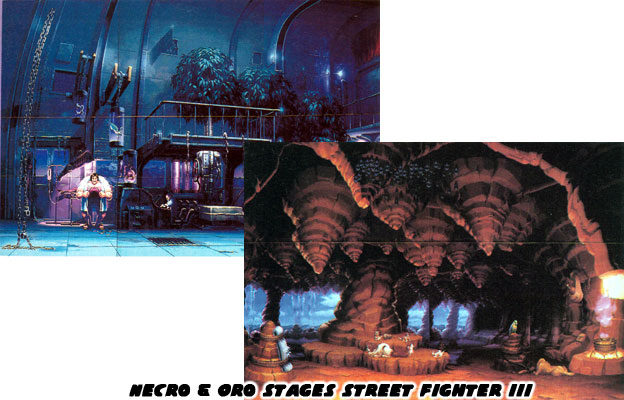The previous blog mentioned that the unused concept art for Street Fighter II would return in future sequels. Street Fighter Alpha / Zero, Street Fighter III and IV all had at least one level that was inspired by earlier concept art. In the early days Capcom was looking at having the entire game take place on one island. Unique areas on that island were highlighted as stages. Even the transportation around the island was considered as the basis for a stage. A cave was envisioned for a bearded hermit-like character in the earliest concept art. The character and his cave was scrapped but returned a few years later with some new refinements. An ancient Brazilian named Oro lived in seclusion. He made an outcropping on the side of a mountain his home and training ground. The previous cave was barren but the new one included animal guests, a cooking pot and punching bag. One of the levels that was also dropped was set on top of a speeding train. Other fighting games that followed Street Fighter II in 1991 did create stages on top of a train. Some were set on top of a moving bus or cable car. Some were featured in titles for the consoles rather than arcade. Capcom did not revisit the idea until 1997 with the release of Street Fighter III. However instead of setting a level on top of a speeding train it was instead set inside of a speeding train. The level was as exotic as the cave in Brazil. The train was actually a two story science lab that the character Necro called home. The mad scientists that had created him were conducting experiments in the background as the European countryside passed in the distance. This was a unique spin on an already unique level design.
The team that worked on Street Fighter III had very few members that had worked on Street Fighter II. Most of the senior members went to work at a new company called ARIKA. It was founded by Akira Nishitani, the programmer credited as "NIN" in many Capcom classics. His team was responsible for the first adaptation of Street Fighter into 3D with the series Street Fighter EX. Many of the same designers that created the original World Warriors went to work creating the EX cast. Many of the new characters served as counterparts if not outright rivals to the original cast. I had talked about many of these characters in my
Based on a True Story series on 1UP. Bruce Lee and several real martial arts masters had inspired the development of the series. Akira and his co-workers then infused more mythology into the series than prior directors. Although the game had amazing fighters that were capable of awe-inspiring attacks, they were grounded in some sense of reality. Anything that couldn't be explained through science was skirted over. ARIKA went in with a slightly different perspective. Although they did not get as far to the magical / demonic extreme as the Mortal Kombat cast they certainly came close through the characters Kairi and Garuda. Those characters had spirit-based special attacks and broke the consistency of the universe to some fans.
ARIKA was having legal challenges with Capcom regarding the use of Street Fighter characters in the EX series. The studio wanted to expand the franchise but found that the publishing arrangement that they had with Capcom was limited. They created a new partnership with Namco, the long-time rival of Capcom. A new fighting game was being developed that would expand on the world that they had created without infringing on any of Capcom's IP. ARIKA did not forget the legacy and designs that inspired Street Fighter II. The movies, locations and characters that inspired the World Warriors remained influential to the designers years later. The original plans for Street Fighter II, especially the ideas that were left on the cutting room floor were revisited. Although their new game was non-canonical it nonetheless paralleled the original vision for SFII. It also introduced many new gamplay elements to audiences. The studio titled this game Fighting Layer.

The graphics engine was in 3D but the majority of the gameplay was in 2D, in keeping with the traditions of the company. Even Street Fighter EX had featured traditional 2D mechanics. Other 3D fighting games like Tekken and Virtua Fighter made limited use of three-dimensional space. The pacing and gameplay for those titles was completely different to 2D fighters like SF, Mortal Kombat or Killer Instinct. Fighting Layer kept the super attacks and special attacks that made Super Street Fighter II popular. The studio also included hidden attacks and combos for players to figure out. The game engine also allowed for ways for players to break out of combos on the ground or in the air. This was a way to help balance the engine against players that were good at performing long combo strings. Players could quit out of their own combos and super attacks and switch them up to keep opponents guessing. This was a mechanic that the studio had employed in the EX series with some success. For beginning players there were simple attacks and combos that could be triggered by pressing one punch or one kick button multiple times. It took several revisions for most fighting titles to get all of these features included in the game engine. Most studios went through a learning curve where they balanced and rebalanced character attacks and abilities. Upgrade kits for Street Fighter II labeled Hyper, Turbo, Championship and Super added many new elements to the game. Arcade owners could purchase these upgrade kits to keep the gameplay fresh. ARIKA tried to roll out a game that had all of the modern mechanics expected in a fighting game. It was an ambitious task. To keep gamers coming back they had hidden content that would be released by an internal clock.
Fighting Layer was not the first 3D fighting game, it did not have the most powerful graphics engine and it was not the first to feature time release characters. It was released in 1998, at a time when fighting games had become passé and the arcade industry was dying off in the US. Most fighting games, including the 3D ones would transition to the consoles thanks in part to the success of the Sony Playstation. When 2000 saw the release of the Playstation 2 there was little reason for long-time gamers to visit the arcade. Fighting Layer was also rarely seen outside of Japan. As such not many players saw or played the title. Those fortunate enough to live near an arcade that imported titles could be considered lucky. Fighting Layer (FL) was not the second coming of Street Fighter II as ARIKA had hoped. It was nonetheless a very solid fighting game.

The title pitted masters of various fighting styles against each other. That was nothing new. However the FL lineup was closer to the plans for the original World Warriors than what Capcom had released. The parallel to the World Warrior designs were eerily familiar yet not in the same way as the Data East game Fighter's History. The Data East game did a wholesale rip-off of Street Fighter II, with a similar control scheme, similar characters, similar levels and even special moves. Capcom took Data East to court for copyright infringement and actually lost the case. The results of which opened up the doors for numerous copycat games to be released. Now that I think about it, I've never spent a blog dissecting Fighter's History. But today is not the day so I'll bring it up some other day. Anyhow Fighting Layers was almost a point for point retelling of the Street Fighter II mythos. It could have been called derivative if not for the fact that the majority of the team also created SFII. Almost a decade separated the two games but ARIKA did not try to make modern versions of the World Warriors. They wanted to make sure that the majority of the fighters wore traditional or pseudo-traditional costumes when possible moreover they also wanted to push the boundaries for what made up those classic designs. While they did not go to the extremes of other studios like Namco, Midway or Rare, they certainly created a lineup that was as memorable as the Street Fighters.
What fighting game from former Capcom employees would be complete if it did not start with a powerful Japanese protagonist? Many gamers expected the return of Kairi from Street Fighter EX. ARIKA designed him to be a rival to Ryu and eventually replace Gouki in canon. Not many behind the scenes or in the fighting game community thought that was a good idea. Regardless Kairi had been elevated to boss-tier character by Street Fighter EX 3 and would not appear in Fighting Layer. The new protagonist was young and heroic. Tetsuo Kato appeared brash and unconventional. With torn sleeves and taped up hands he did seem partially inspired by Kairi but seemed even less refined than Ryu. He was a very powerful karateka that was constantly testing himself against the greatest fighters around the world. Although not a dead-ringer for Ryu he certainly shared his fighting spirit.

Audiences could guess where the influences behind the character were pulled from. The wild spiky hair made him look like Tetsuo, a main character from the manga and animé film Akira. The surname is common in Japan but could also be based on a character that Bruce Lee played in the TV series the Green Hornet. ARIKA followed a tradition that they started with Street Fighter EX. Almost every character that they added to canon had a last name. The designers never included last names for most of the World Warriors and boss characters in the original Street Fighter, SF II or III. However the ones in the planning stages for Street Fighter III that were shoehorned into SF II as the "Super" upgrade did get last names. Cammy White, Dee Jay, T. Hawk and Fei Long all had surnames. It makes you wonder if they were not created from the future ARIKA designers. Tetsuo Kato needed other heroic fighters to accompany him in the newly created Fighting Layer tournament. The core of the group had to be equally passionate as Kato and equally gifted in combat. Although none of the characters knew each other there was something eerily familiar about them. We will go down the rabbit hole in the next blog and take a closer look at the roots of the Fighting Layer designs.
If you would like to sponsor me
please visit my Patreon page and consider donating each month, even as little as $1 would help make better blogs and even podcasts!





